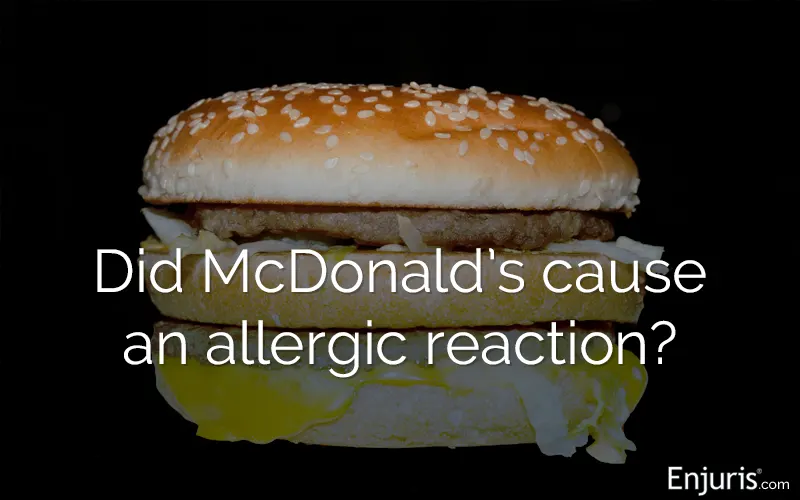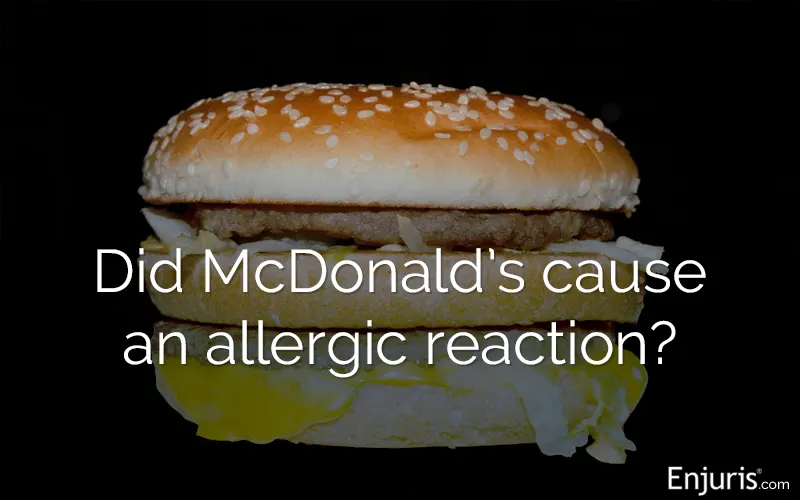[ad_1]

Man suffers life-threatening allergic reaction after biting into Big Mac
A man checked “no cheese” when placing his DoorDash order, but McDonald’s included cheese on his burger, anyway. Is McDonald’s responsible for his allergic reaction?
Do you ever just crave a big, juicy burger? Even if you don’t eat them all the time, you have a reasonable expectation that when you do, it won’t cause you harm if prepared to your specifications.
But that’s not what happened to 28-year-old Charles Olsen of Rockland County, New York. Olsen ordered a McDonald’s Big Mac using the DoorDash app. His online receipt showed that he checked “No American cheese” when placing the order.
Olsen received his meal and took a few bites. He then realized that something terrible was happening. His throat was itchy and swelling, and his body felt like it was burning. He was covered in hives in minutes and began struggling to breathe.
This reaction happened because of the cheese in his Big Mac, even though he specifically requested that it would not be included.
Olsen has an anaphylactic allergy to milk; fortunately, he was with his girlfriend at the time he ate the burger, and she was able to call 911 and have him rushed to the hospital as the reaction began. He almost required intubation to save his life, and he was admitted to the hospital for life-threatening anaphylaxis.
Olsen has since filed a lawsuit against McDonald’s for the incident.
The claims behind the McDonald’s lawsuit
A McDonald’s Big Mac typically contains two beef patties with pickles, lettuce, onion, dairy-free sauce and a slice of American cheese. The lawsuit claims there is no way for a user to mention that a request for an omission or substitution is for a medical reason like an allergy, and not simply a preference.
DoorDash is not a defendant in the lawsuit.
Olsen’s lawyer says there was no mechanism in the app to indicate a food allergy. Another member of the legal team said that the incident was avoidable, and that it was traumatic for Olsen. He said that although he physically recovered, he now has anxiety about getting food from restaurants.
The lawsuit claims McDonald’s was negligent because it breached its duty to ensure that the food it serves is safe to eat.
The Mayo Clinic says that about 2% of children in the U.S. have an allergy to milk or milk products. Many outgrow this allergy, but some don’t. A child or adult with a severe milk allergy must avoid consuming any product that contains milk or milk proteins, like casein.
Is the lawsuit against McDonald’s likely to succeed?
Only time will tell how this will play out in the courts. However, there are a few defenses McDonald’s might try to use. For instance, Olsen was prescribed an EpiPen as an emergency rescue device in the event that he accidentally consumed milk. Most doctors will advise a patient to carry their EpiPen at all times for this very reason, but Olsen reportedly did not have the EpiPen with him at the time.
Second, McDonald’s might argue that even though the app allows a user to select items to be omitted, a reasonable person with a severe allergy is responsible for checking the food before eating it to ensure that it does not contain their allergen.
In some instances, lawsuits have been filed because a person suffered an allergy as a result of cross-contamination. In other words, a food service worker wore gloves that had touched the allergen and then touched their food, thereby transferring the allergen. In that instance, the allergen might not be visible to the consumer and they would have no way of knowing it’s there. But Olsen could have seen the cheese if he’d taken a look at his sandwich before beginning to eat.
Should he have been able to assume that McDonald’s would properly prepare his order without cheese? Yes. But it’s similar to a driver who swerves out of the way if they see another driver on the wrong side of the road—we all take steps to mitigate our own risk of injury every day.
However, Olsen should be protected by the Eggshell Skull Rule. This doctrine holds that a defendant is liable for the plaintiff’s unforeseeable and uncommon reactions to a tortious act, even if the injury is far more severe than what would have been anticipated with an “average” person.
In other words, a defendant must take their victim as they find them, even if the victim’s injuries are unusually severe due to a pre-existing condition.
The court must determine whether McDonald’s failure to omit cheese from Mr. Olsen’s Big Mac was negligent and, if so, how much he is owed as compensation for his injuries.
[ad_2]



